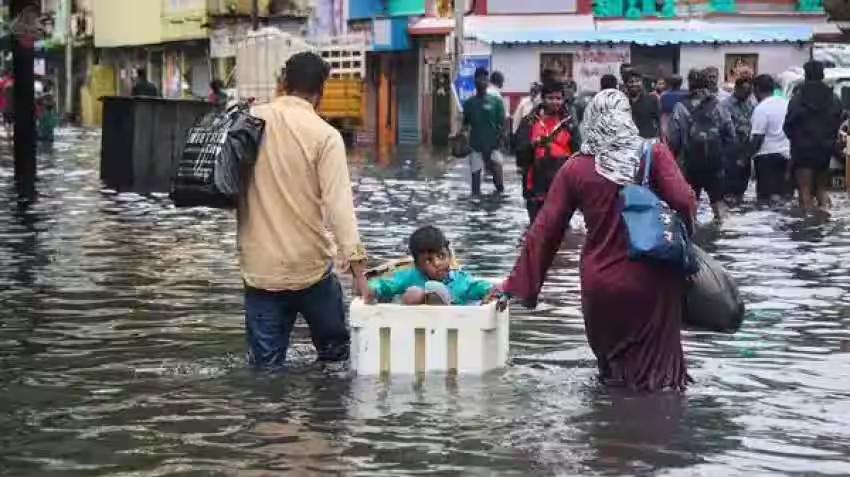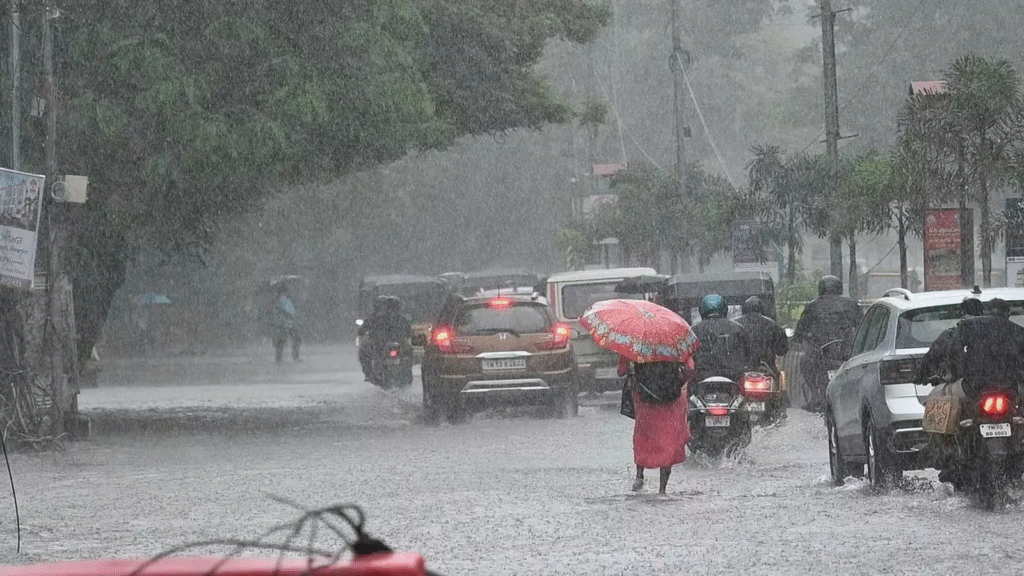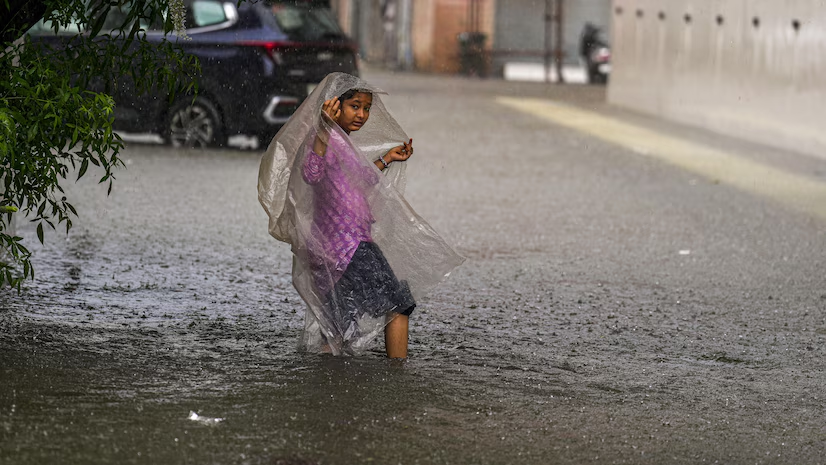
Chennai and its neighboring regions in Tamil Nadu are bracing for an intense spell of heavy rainfall as meteorological agencies have issued a warning for the coming days. The India Meteorological Department (IMD) has sounded an alert, urging residents and authorities to prepare for potential disruptions caused by incessant downpours. This weather development has put Tamil Nadu in the spotlight, as the region readies itself for nature’s unpredictability.
A Surge in Rainfall: What the Experts Say
The IMD’s latest bulletin highlights a deep depression forming over the Bay of Bengal as the primary cause of the heavy rainfall. This system, likely to intensify further, is expected to bring widespread rain across Tamil Nadu, with Chennai being one of the most affected areas. The downpour is forecasted to persist for the next few days, accompanied by gusty winds and thunderstorms.
Meteorologists have identified specific pockets of Tamil Nadu that will bear the brunt of the heavy rain. Chennai, the bustling capital city, along with coastal districts like Cuddalore, Nagapattinam, and Karaikal, are on high alert. Inland regions are also expected to witness moderate to heavy rainfall, potentially causing waterlogging and disruptions in day-to-day activities.
According to weather experts, these intense weather patterns are not uncommon during this time of year. The northeast monsoon, active in Tamil Nadu from October to December, often brings significant rainfall. However, the current system’s strength and its impact on urban areas have amplified the concerns.
The Scene in Chennai: Coping with the Downpour
Chennai, known for its resilience, is gearing up to manage the challenges posed by heavy rainfall. As rain lashed the city overnight, several low-lying areas reported waterlogging. Residents woke up to submerged streets, delayed transportation services, and traffic snarls. Emergency services and municipal authorities were quick to respond, deploying pumps to clear waterlogged areas and ensuring that drainage systems functioned effectively.
Schools and colleges in Chennai have been advised to remain closed as a precautionary measure, ensuring the safety of students. Offices, particularly those in flood-prone zones, are operating with limited staff, with many organizations encouraging remote work to avoid travel disruptions.
The Greater Chennai Corporation (GCC) has activated its disaster management teams, ready to address emergencies. Officials have been coordinating with local police, fire departments, and health services to ensure a swift response to any untoward incidents. Relief shelters have been set up in key areas to accommodate people from vulnerable locations if evacuations become necessary.
The Impact on Daily Life and Infrastructure
The persistent rain has significantly impacted daily life in Chennai and the surrounding areas. Roads submerged in knee-deep water have slowed down vehicular movement, with commuters facing long delays. Public transport, including buses and suburban trains, is operating with reduced frequency, causing inconvenience to thousands of passengers.
Chennai International Airport has also witnessed disruptions, with several flights delayed or canceled due to adverse weather conditions. Passengers have been advised to check their flight schedules in advance and plan their travel accordingly. Meanwhile, the Chennai Port, a vital hub for trade, is monitoring the situation closely, with operations adjusted to prioritize safety.
The city’s power supply has been intermittently affected, particularly in neighborhoods prone to flooding. Electricity board officials have assured residents of swift restoration efforts while urging people to report power outages promptly.
The agricultural sector, a crucial part of Tamil Nadu’s economy, is also feeling the effects of this heavy rainfall. While farmers welcome the rain for their crops, excessive water can lead to flooding of fields, damage to standing crops, and delays in the sowing of new ones. Efforts are underway to minimize agricultural losses through timely interventions and support to affected farmers.
Precautions and Advisory for Residents
As the rains show no signs of abating, authorities have issued a series of advisories to ensure public safety. Residents have been urged to avoid venturing out unless necessary, especially in flood-prone areas. Motorists are advised to drive cautiously, as waterlogged roads can be hazardous and lead to accidents.
Health officials have warned of potential waterborne diseases during such weather conditions. People are encouraged to drink boiled or purified water, maintain hygiene, and seek medical attention if symptoms like fever or diarrhea arise. Hospitals and clinics are on standby to handle any surge in cases resulting from the wet weather.
In addition to these precautions, residents living near rivers and lakes are being monitored closely. Tamil Nadu’s water resources department has been releasing excess water from reservoirs to manage rising levels. While this measure prevents flooding in some areas, it raises concerns for downstream regions, which are being closely observed for any signs of overflow.
Local communities are also playing a role in ensuring safety, with neighborhood groups organizing awareness campaigns and distributing emergency kits. These kits often include items like dry food, bottled water, flashlights, and basic medical supplies to help families stay prepared for unexpected situations.
A Historical Perspective: Chennai and Rainfall
Chennai’s history with heavy rainfall and floods is a tale of resilience and adaptation. The 2015 floods remain etched in the city’s memory as one of the most devastating events in recent times. Over 1,000 millimeters of rainfall in a single month led to unprecedented flooding, affecting millions of lives and crippling infrastructure.
Since then, the city has taken significant steps to improve its preparedness for such weather events. Enhanced drainage systems, disaster response units, and better urban planning have mitigated the impact of heavy rains to some extent. However, the challenges posed by rapid urbanization and climate change continue to test the limits of these measures.
The 2021 Chennai floods were another wake-up call, reminding authorities and residents of the need for constant vigilance and proactive planning. While much progress has been made, the city’s vulnerability to heavy rainfall highlights the importance of sustained efforts to strengthen infrastructure and disaster management systems.

The Role of Climate Change
Experts attribute the increasing frequency and intensity of such weather events to climate change. Rising global temperatures have altered monsoon patterns, leading to unpredictable and extreme weather conditions. Coastal cities like Chennai are particularly vulnerable, with rising sea levels compounding the risks of flooding.
Addressing these challenges requires a concerted effort from governments, communities, and individuals. Strengthening infrastructure, adopting sustainable urban planning practices, and raising awareness about climate change’s impact are crucial steps in building resilience against such natural calamities.
Climate change also calls for global action. International cooperation and agreements, such as the Paris Accord, play a vital role in mitigating the effects of climate change. By reducing greenhouse gas emissions and investing in renewable energy, countries can collectively combat the adverse impacts of climate change on weather patterns.
Government’s Role and Relief Efforts
The Tamil Nadu government has been proactive in its approach to managing the situation. Chief Minister M.K. Stalin has held multiple review meetings with top officials to assess preparedness and coordinate relief efforts. The state’s disaster management team is working round the clock to mitigate the impact of the heavy rainfall.
Financial aid and relief materials have been dispatched to affected areas. Local authorities are distributing food packets, drinking water, and essential supplies to those in need. Medical teams are conducting camps in vulnerable regions to provide healthcare services and distribute medicines.
In addition to immediate relief, the government is focusing on long-term solutions to address recurring flooding issues. Projects to rejuvenate water bodies, strengthen embankments, and improve stormwater drainage systems are underway, aimed at reducing the city’s vulnerability to heavy rainfall.
The government is also collaborating with experts and organizations to develop innovative solutions, such as rainwater harvesting and the use of technology for real-time weather monitoring. These initiatives aim to create a more sustainable and resilient urban environment in the face of changing climate patterns.
Community Solidarity: Chennai’s Spirit Shines Through
Amidst the challenges posed by the relentless rain, Chennai’s community spirit has been a beacon of hope. Residents have come together to support one another, offering shelter, food, and assistance to those in need. Social media platforms are abuzz with messages of help and information, enabling timely responses to emergencies.
Volunteer groups and NGOs have stepped up, coordinating relief efforts and providing essential services in affected areas. From distributing food packets to organizing rescue operations, these groups exemplify the resilience and solidarity that define Chennai’s character.
Neighborhood associations have also been instrumental in ensuring that vulnerable populations, such as the elderly and children, receive the care and support they need during this challenging time. This collective effort underscores the importance of community-driven initiatives in tackling natural disasters.
Looking Ahead: Weather Forecast and Preparedness
The IMD has forecasted that the heavy rainfall will continue for the next 48 hours, with some areas experiencing very heavy rainfall exceeding 200 millimeters. Residents are advised to stay updated with official weather reports and follow the instructions of local authorities.
As the city navigates through this challenging period, the focus remains on minimizing disruptions and ensuring the safety of its citizens. The experience of past weather events has equipped Chennai with the knowledge and resources to manage such situations effectively. However, the unpredictability of nature serves as a reminder of the importance of preparedness and adaptability.
Chennai’s response to this weather event will also serve as a case study for other urban centers facing similar challenges. Lessons learned from this experience can inform policies and practices that enhance resilience to extreme weather conditions.
Conclusion: A City Tested, A City United
The heavy rainfall alert in Chennai and Tamil Nadu underscores the dynamic and often challenging relationship between urban life and nature. While the city grapples with waterlogged streets and disrupted routines, it also showcases the strength of its community and the effectiveness of its disaster management systems.

